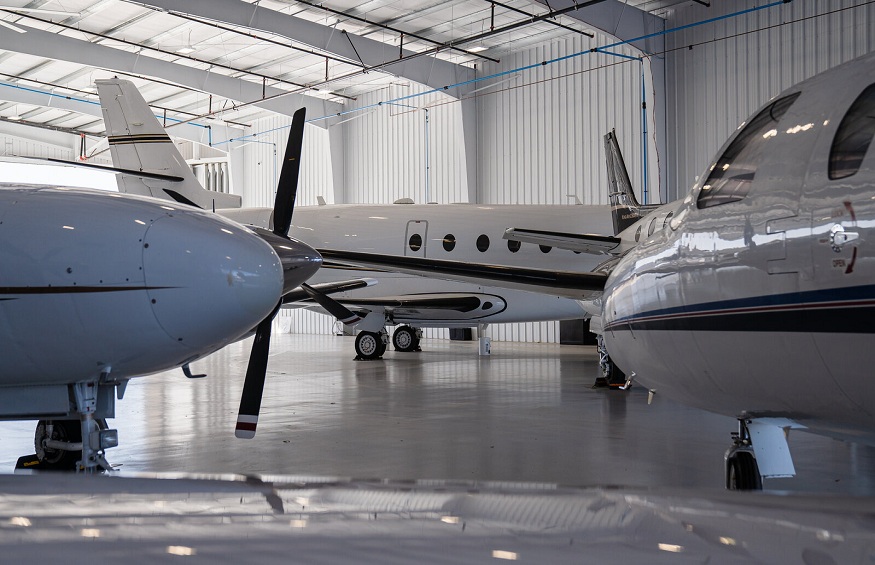Aircraft hangar buildings are crucial for protecting valuable aircraft from the elements, theft, and damage. As such, choosing the right material for building an aircraft hangar is crucial in ensuring that it serves its purpose effectively. The three most common materials used for building aircraft hangars are steel, concrete, and wood. Each of these materials has its own advantages and disadvantages, and the choice of material will depend on the specific needs and preferences of the owner.
Steel Hangars
Advantages
- Durability: Steel is an incredibly durable material, and when used for building aircraft hangars, it can last for several decades with proper maintenance. This makes it an excellent choice for those looking for a long-lasting solution.
- Strength: Steel is known for its strength and can support a significant amount of weight, making it an ideal choice for larger aircraft or those carrying heavy cargo.
- Speed of Construction: Steel structures can be prefabricated and assembled on-site, reducing the construction time significantly. This is especially useful for those who need a quick solution to protect their aircraft.
Disadvantages
- Cost: Steel is typically more expensive than other materials, and the cost can be further increased if the steel needs to be custom-made to fit the specific needs of the hangar.
- Maintenance: Steel is prone to rust, and regular maintenance is required to prevent this from happening. This can be a significant cost, especially over time.
- Aesthetics: Steel structures can be less aesthetically pleasing than other materials, and this may not be suitable for those who want their aircraft hangars to blend in with their surroundings.
Concrete Hangars
Advantages
- Strength: Concrete is a strong and durable material, making it an excellent choice for those who want to ensure their aircraft is protected from damage.
- Fire Resistance: Concrete is known for its fire resistance, and this can be especially important for those who want to ensure their aircraft is protected in the event of a fire.
- Cost: Concrete is typically less expensive than steel and can be a more cost-effective solution for those who want a strong and durable aircraft hangar building.
Disadvantages
- Weight: Concrete is a heavy material, and this can be a disadvantage for those who need to move their aircraft hangars frequently.
- Speed of Construction: Concrete structures take longer to build than steel structures, and this can be a disadvantage for those who need a quick solution.
- Maintenance: Concrete is prone to cracking over time, and this can be a significant maintenance issue, especially if the cracks are not repaired promptly.
Wooden Hangars
Advantages
- Cost: Wood is typically the least expensive of the three materials, and this can be an advantage for those who are on a tight budget.
- Aesthetics: Wood is a natural and aesthetically pleasing material, and this can be important for those who want their aircraft hangars to blend in with their surroundings.
- Ease of Construction: Wood structures are relatively easy to build, and this can be a significant advantage for those who want a quick solution.
Disadvantages
- Durability: Wood is not as durable as steel or concrete, and it is more susceptible to damage from the elements, such as rot and insect damage.
- Fire Resistance: Wood is highly flammable and not fire-resistant, and this can be a significant disadvantage for those who want to ensure their aircraft is protected in the event of a fire.
- Maintenance: Wood requires regular maintenance to ensure that it remains in good condition, and this can be a significant cost, especially over time.
Making an Informed Decision
When choosing the right material for your aircraft hangar, it is essential to consider the specific needs and preferences of the owner. Steel is an excellent choice for those looking for a long-lasting, strong, and durable solution. However, it is more expensive and requires regular maintenance. Concrete is a strong and fire-resistant material, but it is heavy, takes longer to build, and is prone to cracking. Wood is an affordable and aesthetically pleasing material, but it is less durable, flammable, and requires regular maintenance. Ultimately, the choice of material will depend on the specific needs and preferences of the owner, and it is recommended to consult with a professional to make an informed decision.
Another factor to consider when choosing the right material for your aircraft hangar is insulation. Insulation is important for regulating the temperature inside the hangar, especially in extreme weather conditions. Steel and concrete structures are not naturally insulating, so insulation needs to be added during construction. This can be an added cost and can also take up valuable space inside the hangar. On the other hand, wood is a naturally insulating material and can provide better insulation without the need for additional materials.
It is also important to consider the local building codes and regulations when choosing the right material for your aircraft hangar. Building codes vary from region to region and can dictate the type of materials that can be used and the methods of construction. Some building codes may have restrictions on the use of certain materials, such as wood, in high-wind areas. Failure to comply with local building codes can result in penalties, delays, and even the need to tear down and rebuild the hangar.
Conclusion
Choosing the right material for your aircraft hangar is a complex decision that requires careful consideration of several factors. It is essential to consider the cost, durability, insulation, local building codes, and foundation when choosing the right material. A professional can provide valuable advice and guidance to help make an informed decision. Whether you choose steel, concrete, or wood, a well-constructed aircraft hangar building will provide essential protection for valuable aircraft. Get in touch with Coastal Steel Structures for more information.





